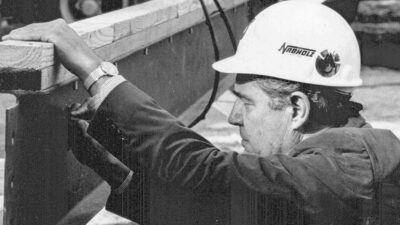The relationship between superintendent and project engineer, or PE, is vital to the success of a commercial construction project. Many times, PEs are the new guys or gals on site. They might have recently graduated with a construction management degree and maybe completed an internship or two while in college. The superintendent, on the other hand, has probably been on jobsites for years, working on $500,000 jobs and $50 million jobs alike. How can these two very different roles work together to ensure a successful job? Bud Lester, Nabholz superintendent, outlines eight rules for new project engineers to ensure they earn their superintendent’s respect.
1. Say it with me: communication, communication, communication.
The superintendent and PE must keep each other informed daily about almost everything happening on the job. This can be a lot of pressure for a young PE. They don’t want the superintendent to think they can’t handle this job. Sometimes PEs will try to take on too much or answer a question incorrectly to try and compensate.
This does not impress a superintendent. In fact, it does the opposite. If I can communicate to my project engineer how important it is to keep me in the loop, I can then teach them the multiple variables that I am considering when making a decision. I ask for certain information based on past experiences when I didn’t make the right decisions.
Simply put, you don’t have to give an immediate answer every time someone asks a question, especially if you’re not sure of the right answer. Don’t agree to terms your superintendent might not agree to. I’ve seen subcontractors go to project engineers after talking to the project superintendent to see if the project engineer will break from what the superintendent says.
If the PE has ANY doubt about something, they need to involve the superintendent in the discussion. Each new situation builds trust, and as time goes on, many of the issues that would once cause a project engineer to pause will become no-brainers.
2. Be a safety advocate.
Safety is all day, every day for everybody, and a project engineer should be an extra set of eyes and ears to help keep everyone safe. Assist your superintendent by helping with the paperwork that comes along with jobsite safety—jobsite copies of the subcontractors’ hazcom manuals, proof of training for aerial lifts and cranes, notices for the trailer, etc.
3. Quality control.
Project engineers are often highly involved with the material submittals approval process, giving them a unique position to affect quality control. They are the best player to enforce Nabholz’ material delivery inspections, random inspections, and miscellaneous checklists. Project engineers that go above and beyond modify checklists to fit the exact materials and manufacturing instructions, and work with the superintendent and subcontractors to have pre-install meetings to insure all proper steps and procedures are followed.
4. Learn our scheduling software.
Your superintendent may not know how to “punch it into the computer” but can see the value in using electronic scheduling software. It’s a good tool to define work activities and help create the flow with the right sequence and coordination. Help your superintendent by mastering scheduling.
5. Get to know the foremen.
The foreman on site is likely the person that knows the Superintendent and his work style best. At Nabholz, foremen also have years of experience that an observant project engineer can learn many lessons from. When the project engineer and foreman team up, it is win-win for everyone. For a project engineer that is just starting out and who may be confused about what matters on a project or what doesn’t, or hasn’t learned the superintendent’s pet peeves yet, a trusted foreman is your new best friend.
6. Paperwork.
Be on top of material submittals, approvals, and shop drawing reviews. If you need help with difficult items, ask the superintendent, project manager, or another in-house expert. Compile a list of required items from shop drawings to help avoid un-expected issues.
7. Stay on top of requests for information, or RFIs.
Make sure there are no oversights and learn to plug in feedback to help speed up answers. Make sure these are current, as they will generate changes to documents that must be kept up to date. Involve your superintendent before the RFI is sent out and make sure to address their feedback or questions.
8. Master Autodesk.
I use Autodesk as an all-inclusive document viewer. A good project engineer keeps Autodesk drawings posted and updated. These should be marked up exactly like the paper as-built set. Note or hyperlink RFI’s and ASI’s on the plan sheets they affect (not just dumped in a folder). Include all red lines and dimensions provided by MEP subs. If this is done right, at the end of the job the Autodesk set of drawings can be printed and will be a mirror image of the Superintendent’s as-built set.

